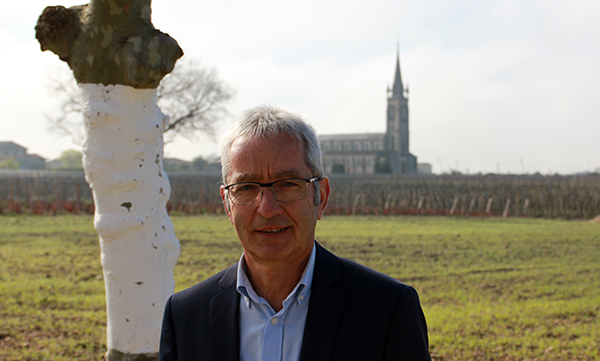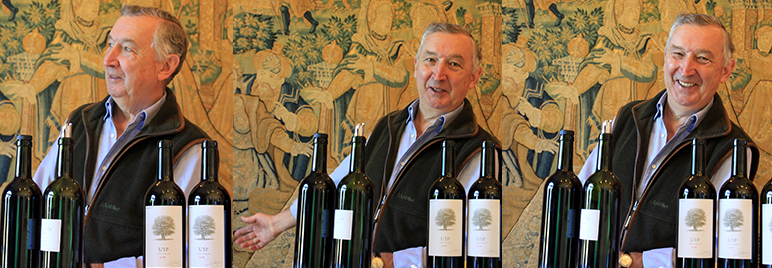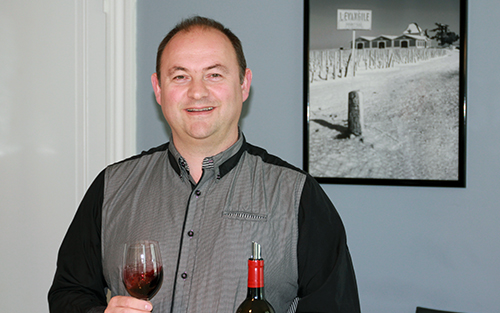Classicism is the name of the day in 2016, but it is certainly a very polished classicism. A return to wines mostly in the 13-13.5% level, so more ‘Englishman’s claret’ than some recent top vintages.

François Mitjavile of Tertre Rôteboeuf
François Mitjavile of Tertre Rôteboeuf was as interesting as ever: “It was a general success, with a very homogenous character. All the grape varieties could be picked in perfect condition and ripeness. The rain in September saved the vines which had begun to work very slowly in the heat so as not to get exhausted. But the idea that Août fait le moût (‘August makes the must’) is now dead. It used to be that the harvest was either early and good, or late and ‘petit’. This is not true now – 2000, 2005, 2010, 2015 and 2016 are sunny summers but which then extend into slow maturation and long ripening. September and October were moderate – sun by day and nights that were cool. It’s rich but it’s aerial because of the late cool harvest: a vintage of fresh opulence.” He does not make a second wine. The Domaine des Cambes comes from different plots – vines on the foot of the slopes of Roc des Cambes. At Tertre Rôteboeuf, he makes just one wine « c’est au coeur de la poésie du vin qu’on fait des millésimes purs », (“it’s at the heart of the poetry of wine that one makes pure vintages” i.e. the wine reflects the whole production of the whole vineyard in each year) and “the authenticity of a wine from a vineyard and a year is a great civilisation, like a classical music”. He also mentioned that the 2016s have some of the « grace aromatique » of 2006, and we were lucky enough to taste a 2006 later at Conseillante which was wonderful, so maybe this is a good comparison on the right bank.

Pierre Taïx of La Mauriane
Pierre Taïx of La Mauriane described the fruit as ‘fragile’, and said that overall the whites are not good this year – aromatic but ‘pateux’ (pasty, heavy) – the September rain came too late for them. It was important to pick early enough to retain the brighter fruit elements – just because you could wait longer did not mean you should – was a sentiment we heard often. “For me the slight vegetal taste is an integral part of Bordeaux – it reminds one that Bordeaux is after all a terroir Atlantique”. He went on to gently rail against the practice of thermovinification, a technique developed in the Languedoc in which the must is heated to 80C for a short period. “40% of Bordeaux (ie straight ac Bordeaux) is made this way – lots of colour and you burn off any pyrazines (the elements which give leafy and green aromas) – you can bottle it after seven months but two years later it is dead. Some top growths use this on the Cabernet to get rid of the pyrazines.”

The line-up at Église Clinet
Denis Durantou of l’Église Clinet said that 2016s are ‘wines to drink, not to taste’ – meaning, we took it, that they are less ‘impressive’ than a vintage with more amplitude like 2010, but that they are likely to be brilliant to drink, and we’d concur – most enjoyable at their maturity, at table, with food.

Denis Durantou of Église Clinet
Jacques Thienpont, asked his opinion of the vintage, said “Oh, we will sell it”. Not much doubt about that then.

Jacques Thienpont with samples of l’If and Le Pin – and his Flemish tapestry ‘won’ at auction.
Alexandre Thienpont of Vieux Château Certan said that the young vines really suffered from the drought: “the violent contrasts of the growing season really exaggerate the terroir effect. 2016 really shows the style of each terroir”.
Jean-Pascal Vazart at L’Évangile described it as a very « sympathique » vintage, with extremely polished tannins, but which the acidity was blocking a bit – “there’s an extreme power contained in the wines, it’s the élevage which will reveal it”.

Jean-Pascal Vazart at L’Évangile
Florence Cathiard at Smith Haut Lafitte said it really was a year for Cabernet (again this was echoed elsewhere, but obviously less on the right bank). “The Merlots are at the same level as 2015, but the Cabernets are better”. She explained how their growing and vinifications are always evolving – ‘bio-precision’ in the vineyard, less sulphur in the winery. They’ve always had their own cooperage, but now also have their own vine-grafting operation, on an island in the Garonne, to keep it away from pests. The chef de culture, Fabien Teitgen, is known locally as ‘the ghost’ as he patrols the vineyard on a Segway, surveying for exactly what treatments may be required, and where.
At Haut Bailly they were keen to say that in the end 2016 is in the average of total rainfall – it just fell very irregularly. They likened 2015 to 2009 – very ‘flatteur’ (which does not quite translate to ‘flattering’, but easy, approachable, lush etc.), while 2016 is more like 2010 – all about purity and length. While this is sort of true it’s not quite right either, as the 2016s have less alcohol and sheer mass than 2010s.
At Carmes Haut Brion, Guillaume Pouthier talked about the floral fruit in the Carmes, “iris, peony, violet”, before going on to say that there is huge concentration in the wine this year, but that it is hidden by the glossy fat – but that he thinks it will drink from ten to fifty years from now. We’ve been a little more conservative with our longevity estimates.
Many wines have very high IPT (indexe de polyphenoles et tannins) levels, often similar to, or in the case of Lynch Bages for example, higher than, those reported in 2009 and 2010. Smith Haut Lafitte would not give us the IPT level saying it was not a good measure as it depends on where you base the index, but that Smith has 5 grams per litre of polyphenols – we are not sure just how high this is in relative terms, but they obviously felt it was high. IPT levels alone are not a determinant of quality, but they are an indicator – if a wine can have as easy a flow and feel of freshness and have these levels of dry extract, it certainly implies that they are very beautifully balanced.
At Cos d’Estournel, Aymeric de la Gironde told us 2016 is a “very civilised vintage. Love the result, but we went through moments that challenged our hearts and our blood pressure. The challenge was not to over-react. Some people did, with extra de-leafing in June – but that could have been disastrous after. A vintage for wines that express truly where they are from.” The wines (Goulée, Pagodes and Cos) are about 13% – “something we are working towards – I like the balance, enjoyable now and perhaps for the next 20 years.”
At Ducru Beaucaillou they wanted to stress how long it had been between flower and harvest. Normally reckoned to be about 100 days as a rule of thumb, 2016 was 125 days. This long ‘hang-time’ – slow maturation – is considered good for quality if matched to a harvest brought in in optimal condition, as was the case for 2016.
In Margaux there were some strikingly successful wines with one thing in common – Palmer, Durfort Vivens and Ferrière all lost crop to mildew in June during the flowering as they all practice biodynamic viticulture and were only able to treat with ‘boullie bordelaise’ – copper sulphate. Was this loss of crop beneficial in the end, as it is clear some of their neighbours in classic viticulture were struggling to ripen the full weight of the crop? Palmer’s Petit Verdot was cropped at three bunches per vine, a pitiful 12-15 hectolitres per hectare.

